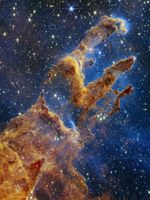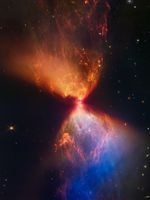How the James Webb Space Telescope transformed astronomy this year – Oregon Public Broadcasting

James Webb Space Telescope launched on December 25, 2021. Its first images – like this one of the Carina Nebula – stunned researchers.
NASA, ESA, CSA, STScI
One year ago, the James Webb Space Telescope began its journey through space.
“JWST was launched on Christmas day, and then was a present that took six months to unwrap,” said Jane Rigby, an astronomer at NASA and the Operations Project Scientist.

The Pillars of Creation were first photographed by Hubble in 1995. Webb’s image reveals countless newly formed stars glistening amongst the columns of gas and dust.
NASA, ESA, CSA, STScI
After an initial calibration period, the telescope started collecting data. And the first results amazed astronomers.
“I downloaded the data, and I’m like, sitting in my pajamas…you know, it’s pandemic, we’re all working from home,” Rigby said. “I pulled down those data, and just started paging through them, pouring through them. And it was so beautiful.”
The telescope is only five months into its science mission, and it’s already transforming astronomy. The telescope’s instruments have allowed it to capture previously unobservable planets, stars and galaxies near and far.
NPR spoke with three astronomers in different disciplines of astronomy about how JWST is advancing research in their area of expertise. They all agree JWST is a game changer, and that there’s plenty more groundbreaking research still to come.
“The ring systems just pop right out, and they’re gorgeous”

JWST’s images of Neptune are some of the clearest of the planet’s rings taken in decades. The bright bluish object is Neptune’s large frozen moon, Triton.
NASA, ESA, CSA, STScI
Heidi Hammel is a planetary astronomer and an interdisciplinary scientist on the JWST Project. She joined the team in 2002 because she wanted to study the planet Neptune.
In September, JWST trained its mirrors on the ice giant.
“When I first saw the image on my computer screen, I was so emotional,” Hammel said. “I first started crying, and then I started shouting and calling all my relatives to come look at this picture!”

This is the clearest view of Neptune’s rings in decades, taken by JWST. Observed here in near-infrared wavelengths, Neptune appears ghostly white instead of blue.
NASA, ESA, CSA, STScI
Prior to JWST, Hammel said, astronomers had never clearly observed Neptune’s ring system. The Voyager spacecraft flew past Neptune in 1989, but could only capture the brightest parts of the planet’s rings.
JWST’s instruments spotted the rings with unmatched clarity.
“Boom! The ring systems just pop right out, and they’re gorgeous,” Hammel said.
“Like stepping out of a virtual reality into the real world”
Outside of our own solar system, JWST has also helped astronomers observe the oldest and most distant known galaxies.
“I’ve been looking at simulated data, trying to mimic what JWST would see, for many years now. So when I first saw the data, it was like stepping out of a virtual reality into the real world,” said Brant Robertson, a professor of astronomy and astrophysics at the University of California, Santa Cruz.
Robertson is on a team of researchers who discovered the oldest galaxies ever observed. JWST’s instruments allowed his team to identify galaxies up to 13.4 billion years old – galaxies that would have formed less than 400 million years after the Big Bang, a tiny fraction of the universe’s lifetime.

Hundreds of galaxies appear in this image, which combines near-infrared colors captured by Webb’s telescope with those from Hubble.
NASA, ESA, CSA, A. Pagan (STScI) & R. Jansen (ASU)
“By finding these very early galaxies, we can learn something about our history, about the history of the universe in general, but also specifically about our home,” said Robertson.
Robertson said that, while older telescopes like Hubble gave astronomers a glimpse of what was out there, JWST has expanded the scope of what kind of science is possible.
“It’s like opening a book that you’ve wanted to know the ending of for a long time but have been holding off on reading that concluding paragraph,” Robertson said, “and then finally seeing the full story revealed to you.
“Pretty much everything we’re doing wasn’t possible before this telescope”
Jane Rigby, JWST’s Operations Project Scientist, is also using the telescope to study distant galaxies.
A naturally occurring phenomenon called gravitational lensing magnifies the light from the galaxies Rigby is observing – combining that with JWST, she’s been able to cut through cosmic dust to study how stars are forming in these galaxies.

Webb captures the image of a protostar, the very beginning of a new star. The “hourglass” of dust and gas clouds is only visible in infrared light, the wavelengths Webb specializes in.
NASA, ESA, CSA, STScI
“Pretty much everything we’re doing wasn’t possible before this telescope,” Rigby said.
Hubble’s instruments wouldn’t have been able to see through the dust obscuring these galaxies, Rigby said. Furthermore, JWST’s instruments allow her to study the material composition of these galaxies through spectroscopy, a technique astronomers commonly use to identify the chemical makeup of objects in space.
“We’re studying where stars are forming in these lensed galaxies in ways that are just laughably not possible with any other telescope,” Rigby said.
JWST has already proven to be an incredible tool for astronomers, but its biggest discoveries are still yet to come, Rigby said.
“We’re just starting to get this flood of papers announcing discoveries,” she said. JWST is being used to study planets in our own solar system, atmospheres of planets in other solar systems, how stars die, how galaxies evolve, and much more, Rigby said.

Pictured here in unprecedented detail, a dying star expels gas and dust. Photos like this from JWST will help further our understanding of how stars evolve.
NASA, ESA, CSA, STScI
And despite JWST being significantly more powerful than previous telescopes, Rigby says astronomers can still use Hubble to complement JWST’s observations.
“In many ways, JWST was built to do the things that Hubble can’t, so they play really well together,” Rigby said. “The pitcher and the catcher on your baseball team do different things.”
The telescope has enough propellant onboard to last more than 20 years in space, Rigby said, so it’s possible it could outlive its planned minimum mission of five years.
“I think that next year is going to be even more exciting than this year,” Rigby said.
After all, it will take time to sift through the data the James Webb Space Telescope collects and see just how much it can shift our understanding of the universe’s many mysteries.
Copyright 2022 NPR. To see more, visit https://www.npr.org.






